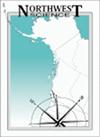监测华盛顿州埃尔瓦河大坝拆除后海洋衍生氮向河岸地区的回归
IF 0.5
4区 环境科学与生态学
Q4 ECOLOGY
引用次数: 1
摘要
摘要太平洋西北岸区的两大氮源分别是通过产卵太平洋鲑鱼(Oncorhynchus spp.)获得的海源氮(MDN)和通过红桤木(Alnus rubra)获得的大气固氮。最近拆除了西澳埃尔瓦河上的两座大型水坝,为鲑鱼开辟了大约60公里以前无法进入的河流栖息地。我们使用天然丰富的稳定氮同位素建立基线数据,以监测大坝拆除后埃尔华河支流河岸地带MDN的流入情况。我们在一个未建坝的参考地点,沿着三条支流,一条位于原水坝之间(自2012年起有溯河鲑鱼进入),另一条位于原水坝上游(无溯河鲑鱼),在固氮红桫椤(A. rubra)和大叶枫(Acer macrophyllum)的地点,对河岸土壤、林下植被和林下植被进行了采样。根据土壤和植被的δ15N测量,我们没有在任何支流(包括参考支流)检测到MDN。而原坝间林下河岸植被δ15N值高于其他支流,这可能与上游人为氮源有关。尽管红叶杨的叶片同位素差异明显,而且红叶杨凋落物的全氮含量较高,但红叶杨和大叶杨样地的土壤和林下植被同位素差异不大。对这些地区以及埃尔瓦河上游地区的监测将使我们能够追踪MDN向流域的回归,并有助于澄清溯河鱼类在河岸生态系统中的作用。本文章由计算机程序翻译,如有差异,请以英文原文为准。
Monitoring the Return of Marine-Derived Nitrogen to Riparian Areas in Response to Dam Removal on the Elwha River, Washington
Abstract Two sources of nitrogen to Pacific Northwest riparian areas are marine-derived nitrogen (MDN) via anadromous Pacific salmon (Oncorhynchus spp.) and atmospheric nitrogen fixation via red alder (Alnus rubra). The recent removal of two large dams on the Elwha River, WA, opened up about 60 km of previously inaccessible river habitat for anadromous salmon. We used naturally abundant stable nitrogen isotopes to establish baseline data to monitor the influx of MDN to riparian zones of Elwha River tributaries post dam removal. We sampled riparian soil, overstory, and understory vegetation in sites with nitrogen-fixing A. rubra and sites with bigleaf maple (Acer macrophyllum) at an undammed reference site, and along three tributaries, one between the former dams (accessible to anadromous salmon since 2012) and the others upstream of the former dams (no anadromous salmon). Based on δ15N measurements of soil and vegetation, we did not detect MDN at any of the tributaries, including the reference tributary. However, the understory riparian vegetation between the former dams had a higher δ15N than the other tributaries, which may be due to upstream anthropogenic nitrogen sources. Although A. rubra foliage was isotopically distinct from A. macrophyllum, and A. rubra litter had higher total nitrogen, soil and understory vegetation in A. rubra and A. macrophyllum sites did not differ isotopically. Monitoring of these areas and those further upstream on the Elwha River will allow us to trace the return of MDN to the watershed, and help to clarify the role that anadromous fish play in riparian ecosystems.
求助全文
通过发布文献求助,成功后即可免费获取论文全文。
去求助
来源期刊

Northwest Science
环境科学-生态学
CiteScore
1.30
自引率
0.00%
发文量
23
审稿时长
>36 weeks
期刊介绍:
The pages of Northwest Science are open to original and fundamental research in the basic, applied, and social sciences. All submissions are refereed by at least two qualified peer reviewers. Papers are welcome from authors outside of the Pacific Northwest if the topic is suitable to our regional audience.
 求助内容:
求助内容: 应助结果提醒方式:
应助结果提醒方式:


